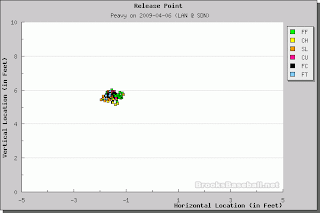When the White Sox traded for an injured Jake Peavy last year, they did so knowing that he'd have some obstacles to overcome to have success in the American League. First of all, the injury. Second of all the transition to the American League which in a general sense isn't nearly as forgiving as the National League.
After watching him throw 20 innings of three run baseball at the end of the year last season, many of those concerns should've been allayed. The innings were good at just under seven per start and the ancillary stats: 18K, 6BB, 1HR were strong as well.
This season the results have been much worse, and I'm concerned that it isn't going to get better any time soon. First, the numbers;
4GS / 22.1 IP / 26H / 15BB / 15K / 3HBP / 3HR
The numbers aren't off in just one area, they're off everywhere. All the good numbers, strikeouts, innings pitched, are down. And the bad ones, walks, home runs, hit batters, are way up.
Generally speaking you write off early season performances because the sample sizes are too small to matter. But just watching him the past couple games, he look different than he did when I watched him a couple seasons ago. However, knowing that you can't usually trust your eyes, I decided to take a look at his PitchFX data to see if he was actually doing anything differently.
I'll be looking at the data from his last start (4/22/10) vs a start where he was going well back in 2009 (4/6/09 vs the Dodgers), before he torn the tendon in his ankle.
Well put the charts next to each other so you can see what Good Peavy and Bad Peavy look like side by side.
Notice the significantly tighter release groupings in this image.
These are the results of an inconsistent release point. Pitches that don't end up where you want them. Small, almost imperceptible differences out of the hand lead to very noticeable differences by the time the ball reaches home plate.
Here it might appear pitches are missing too. But a close look reveals that they're 'missing,' where they're supposed to. The slider is missing middle of the plate, down and away. The only pitch that is consistently 'off' is the fastball which he's locating to set up other pitches.
For the most part, all the pitches are pretty flat. Which is a big reason why hitters are making contact with over 84% of his pitches they swing at this season, vs around 75% for his career.
Here you can see how much better the movement of Peavy's pitches was. Particularly with his slider which faded hard from the swing of left-handers, and the slider which dove from right-handers. Those out pitches were keys for him, and this year, they just aren't there.
So there you have it. Jake Peavy is out of whack.
His command is being affected by his inability to find consistent release points, and his movement is nowhere to be found.
You can see the results in the stats, the increased fly ball and walk rates, the decreased strikeout rates. But the charts confirm that it's not just early season bad luck. Jake Peavy is a noticeably different pitcher than he is when he's on and it's likely going to take more than just a little tinkering for him to get back on track.
That's bad news for the White Sox who were going to be relying on him heavily in 2010 to contend.






No comments:
Post a Comment